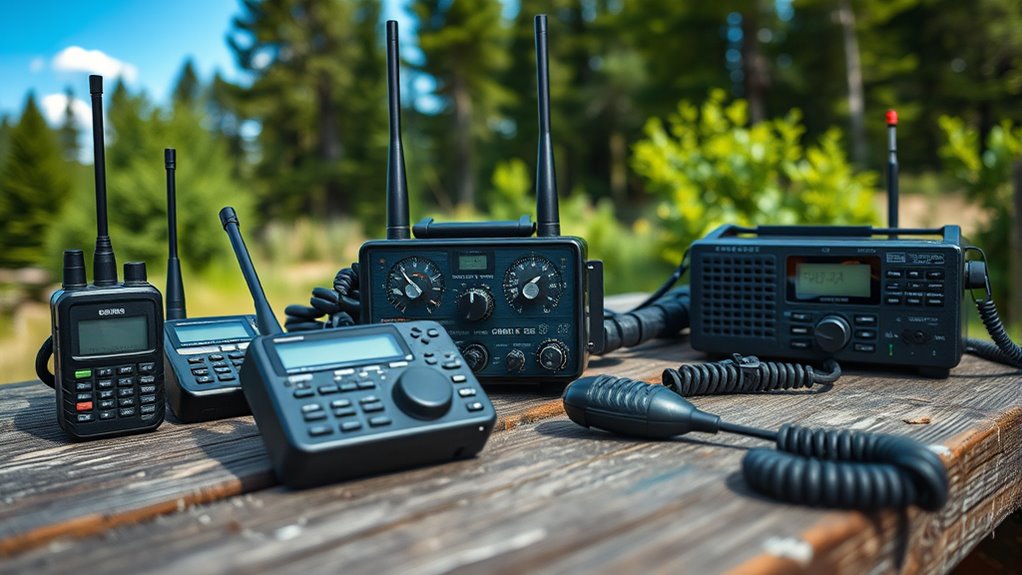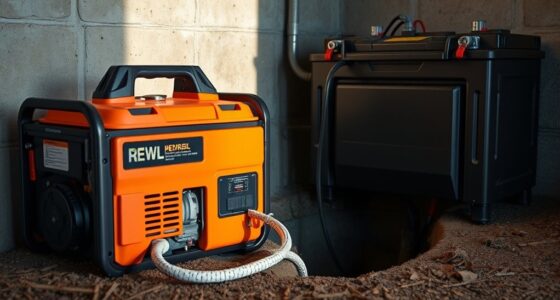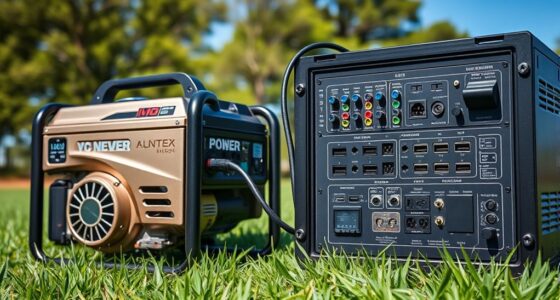To establish emergency communications with FRS, GMRS, or ham radios, first choose the system that best fits your needs and environment. Obtain the necessary licenses, like a GMRS license if using higher-powered radios, and program your devices with essential channels, including emergency frequencies. Develop a clear communication plan, connect your radios to existing infrastructure if possible, and regularly maintain and test equipment. Proper operation and ongoing training ensure your system stays ready—trust us, there’s more to learn to optimize your setup.
Key Takeaways
- Select appropriate radios (FRS, GMRS, or ham) based on range, environment, and communication needs.
- Obtain necessary licenses, such as a GMRS license, and ensure compliance with FCC regulations.
- Program radios with critical emergency channels, including local emergency frequencies and repeater links.
- Develop an emergency communication plan detailing channels, roles, and procedures for quick deployment.
- Regularly test, maintain, and update radio equipment and programming to ensure reliable operation during emergencies.
Choosing the Right Radio Service for Emergency Situations
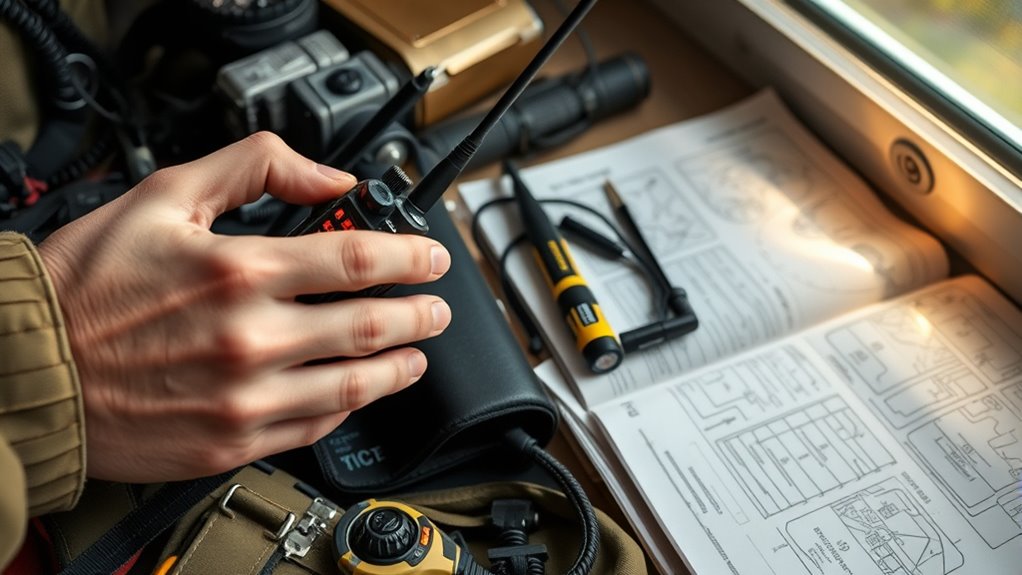
Choosing the right radio service for emergency situations depends on your specific needs and circumstances. If you want quick, easy setup with no licensing, FRS radios are ideal—they’re simple to use and work well for short-range communication up to 1-2 miles in open areas. If you need more range and better coverage, GMRS radios offer higher power (up to 50 watts) and access to repeaters, extending communication up to 25 miles depending on terrain. For broader or cross-region capabilities, ham radios provide the widest frequency range and advanced modes, but they require passing an exam and obtaining a license. The spectrum properties of ham radio enable extensive propagation and long-distance reach, so consider your environment, technical skills, and communication range when choosing a service to make sure of reliable, effective emergency communication. Additionally, understanding the regulations and licensing requirements for each service can help you select the most appropriate option for your needs. Being aware of spectrum characteristics can also help you optimize your setup for different scenarios.
Understanding Licensing Requirements and Obtaining Permits
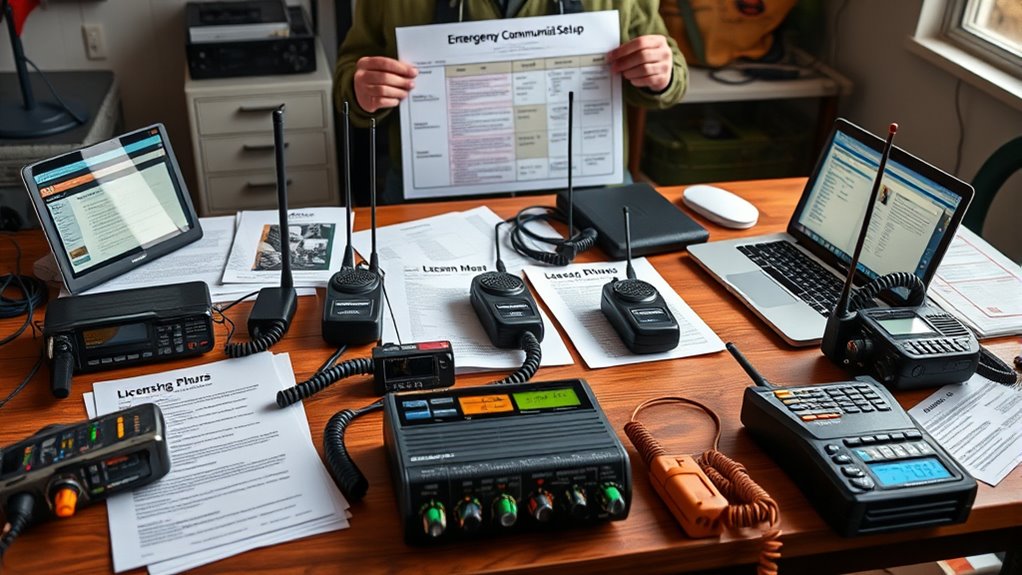
Understanding licensing requirements and obtaining permits are essential steps before using GMRS radios for emergency communication. In the U.S., you must have an FCC license to operate GMRS frequencies legally. The process is straightforward: you need to be at least 18 years old, pay a $35 fee, and submit an application online—no exam is required. The license covers you and your immediate family for up to 10 years, allowing you to operate radios at higher power levels and access repeaters. Failing to obtain a license can lead to fines or equipment confiscation. Be sure to follow FCC rules, including proper call sign identification. Renewal reminders help you keep your license active and compliant, ensuring reliable emergency communication when you need it most. Additionally, understanding amateur radio and its regulations can enhance your preparedness for various emergency scenarios.
Programming Radios With Essential Emergency Channels and Frequencies
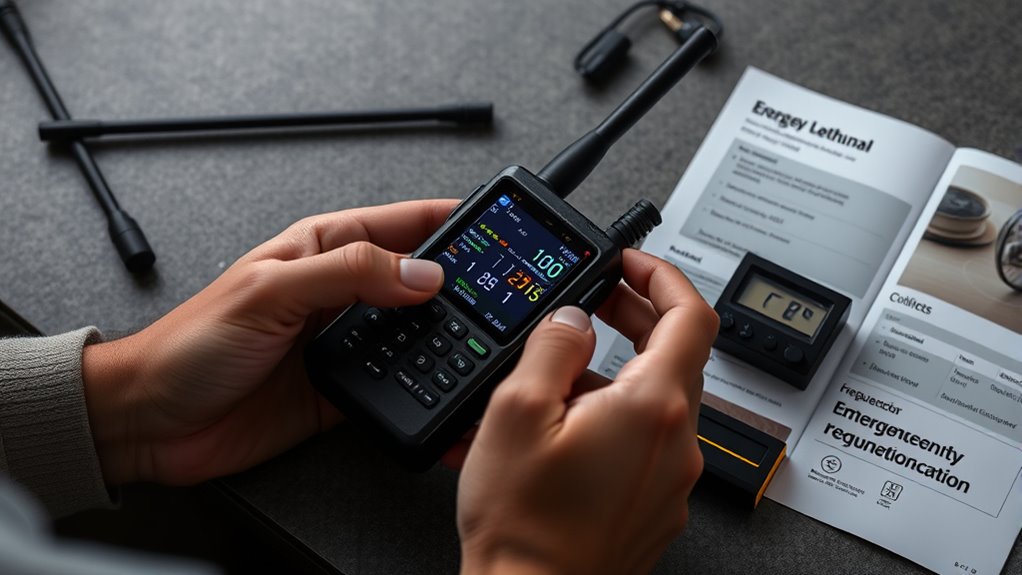
You need to program your radio with critical emergency frequencies to guarantee quick access during crises. Focus on saving essential channels like 146.52 MHz for ham emergencies and local police or fire channels where permitted. Properly setting and labeling these channels helps you stay prepared and respond effectively when it matters most. Additionally, familiarize yourself with specific frequencies used by local agencies to ensure comprehensive coverage during various types of emergencies.
Selecting Critical Frequencies
Selecting the right frequencies for emergency communications is essential to guarantee reliable and effective contact during crises. Prioritize GMRS channels 15-22 for higher power and longer range, especially in emergencies. Also, include primary FRS channels 1-7 for short-range, license-free communication. To avoid interference, steer clear of channels used for commercial purposes. Monitoring local emergency services and repeaters enhances connectivity. Use this table to guide your frequency selection:
| Priority | Frequency Range | Power Level | Notes |
|---|---|---|---|
| GMRS | 462-467 MHz | Up to 50W | For extended range, licensed use |
| FRS | 462-467 MHz | Up to 2W | Short-range, license-free |
| Emergency | Local Repeater | Varies | Check local channels |
| Weather | NOAA Radio | 162 MHz | For weather alerts |
| Avoid | Non-emergency channels | N/A | Minimize interference |
Additionally, understanding regulatory compliance requirements helps ensure your emergency communication setup adheres to legal standards. Proper programming radios with these essential channels is crucial for maintaining effective contact during emergencies. Being familiar with emergency channel protocols can further improve communication efficiency when it matters most.
Setting Emergency Channels
How can you guarantee quick access to critical emergency channels when every second counts? The key is programming your radio with prioritized emergency channels. Start by assigning GMRS Channel 19 as your main emergency channel and Channel 20 as the calling frequency. Program these as presets for instant recall, ensuring they’re clearly labeled. Use software and a computer interface to set the correct frequencies, CTCSS tones like 141.3 Hz, and repeater settings if applicable. Include both simplex channels for direct communication and repeater-linked frequencies for extended reach. Keep emergency channels at the top of your programming menu for rapid access. Proper channel organization ensures quick and efficient response during emergencies. Color accuracy impacts your ability to quickly identify and interpret signals during emergencies, so calibrate your display for optimal clarity. Additionally, reliable communication depends on maintaining up-to-date programming and regularly testing your channels to ensure readiness. Regularly reviewing emergency protocols and practicing communication drills can further enhance your preparedness. Consistent, well-organized programming allows you to respond swiftly, maintaining clear communication during emergencies.
Saving Programmed Settings
To guarantee your emergency communication setup remains reliable, it’s vital to save your programmed settings after configuring your radio. Using software like CHIRP streamlines this process, allowing you to store frequencies, privacy codes, and other settings directly into your radio’s internal memory. Saving ensures your channels and emergency frequencies stay intact after powering off, which is essential in crises. You can also synchronize multiple radios by exporting and importing channel lists, maintaining consistent settings across devices. Regular backups of your radio data files help restore configurations if you reset or experience a failure. Additionally, understanding advanced programming techniques can optimize your radio’s performance and ensure all critical channels are correctly configured. It’s also important to stay updated on software compatibility to prevent issues with your programming tools. Keep in mind, some radios may require specific cables or software updates. Being aware of regional regulations can help ensure your setup complies with local laws and prevents legal issues. By saving your settings properly, you guarantee your emergency channels are ready and reliable whenever you need them most. Incorporating firmware updates can further enhance your radio’s stability and security.
Developing a Comprehensive Emergency Communications Plan

Creating a thorough emergency communications plan is essential for ensuring effective response during crises. You need to define clear goals based on potential hazards, geographic risks, and your scope—whether for a single site or the entire community. Identify your audiences, including employees, emergency responders, vulnerable populations, and media, tailoring messages to their needs. Assign roles like spokespersons and responders, and train your team regularly. Develop documented procedures with channels, approval processes, and escalation steps to ensure swift action. Clarify activation criteria and review plans periodically to keep them current. Incorporating reliable communication devices can significantly enhance your preparedness and response capabilities. Understanding top-rated communication devices can significantly improve your preparedness and response capabilities. Additionally, selecting approved communication channels ensures your messages reach all relevant parties without delays or interference. Incorporate drills and feedback to improve your approach continuously. Establishing a comprehensive communication plan ensures all stakeholders are prepared and aware of their responsibilities in an emergency. By establishing these foundational elements, you’ll ensure your organization communicates effectively, reducing chaos and enhancing safety during emergencies.
Integrating Radio Systems With Existing Emergency Infrastructure
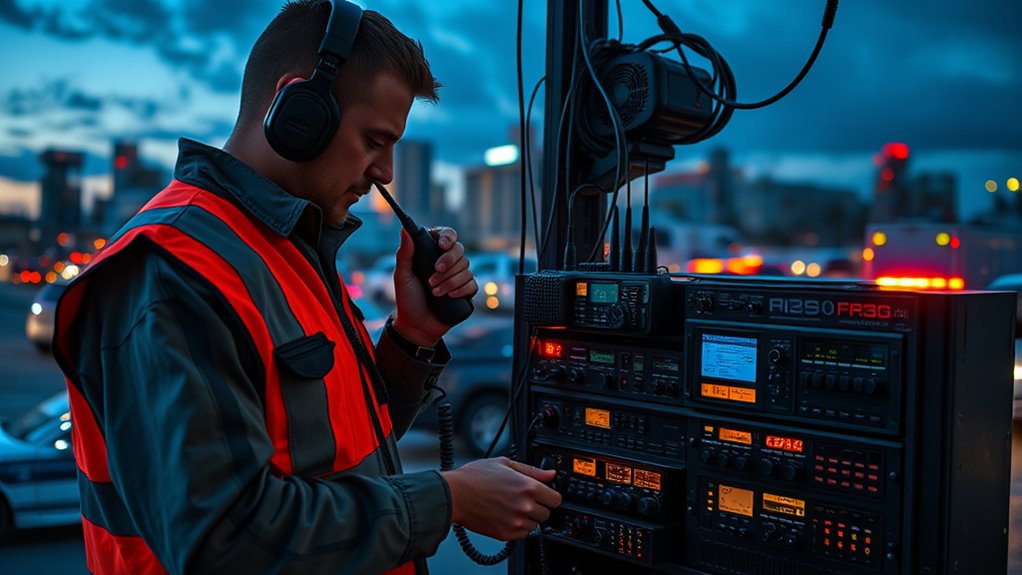
To effectively integrate your radio systems with existing emergency infrastructure, you need to ensure compatibility with public systems and digital options for seamless communication. Accessibility features like alert notifications ensure your team stays informed during crises, regardless of the technology used. Incorporating innovative materials can further enhance the durability and performance of your communication devices in emergency situations. Additionally, understanding the effects of environmental factors on device operation can help maintain reliable communication during critical moments. Recognizing the importance of essential oils in maintaining well-being during stressful situations can also support responder resilience. Cultivating creative practice can foster innovative solutions for communication challenges in emergency scenarios.
Compatibility With Public Systems
Integrating FRS and GMRS radios with public emergency systems presents significant challenges due to differences in frequency bands and licensing requirements. FRS/GMRS share 22 UHF channels, but public safety uses VHF or different UHF bands, limiting direct communication. GMRS’s higher power and repeater use can improve interoperability, but FRS’s limited range and licensing restrictions hinder seamless integration. Compatibility often depends on additional equipment like cross-band repeaters or interface devices.
| Method | Description |
|---|---|
| Cross-band repeaters | Bridge incompatible frequencies for communication |
| Dual-equipped radios | Operators with multiple radios facilitate bridging |
| Portable repeaters | Extend range and connect to emergency infrastructure |
| Pre-established protocols | Ensure coordinated, interference-free operations |
Digital Integration Options
Digital integration options enable radio systems like GMRS, Ham, and FRS to connect seamlessly with existing emergency infrastructure. You can extend communication range using repeaters linked to digital networks via internet gateways, allowing analog radios to interface with digital systems. Proper configuration and licensing are essential to guarantee legal, interference-free operation. Integrating repeaters creates redundancy, maintaining communication when cellular networks are down. Digital link interfaces connect GMRS and Ham radios to VoIP networks used by emergency services, broadening coordination. Digital bridging allows different radio services—FRS, GMRS, Ham—to communicate by converting analog signals into digital packets, improving interoperability. Software-defined radios (SDRs) provide flexible digital modes and remote operation, while IP-based networks link repeaters, dispatch, and incident command, ensuring seamless data and voice flow during emergencies.
Accessibility and Alert Features
Effective accessibility and alert features in radio systems are crucial for ensuring rapid communication during emergencies. They help reach diverse populations quickly and clearly. Using simple voice communication on FRS/GMRS radios allows anyone to send alerts without complex interfaces. Repeater capabilities extend coverage, helping isolated or mobility-limited individuals. Pre-configured channels with call signs improve immediate recognition and response. Portable, handheld radios enable alerting at shelters and along evacuation routes, even when infrastructure is compromised. Trained message managers ensure messages are clear and concise, reducing confusion. Integration with emergency infrastructure, like EOCs, enhances multi-tier coordination. However, challenges like limited repeater coverage in rural areas and compatibility issues may hinder seamless communication. Proper planning and training are essential to maximize these accessibility and alert features effectively.
Maintaining Equipment for Reliable Emergency Use
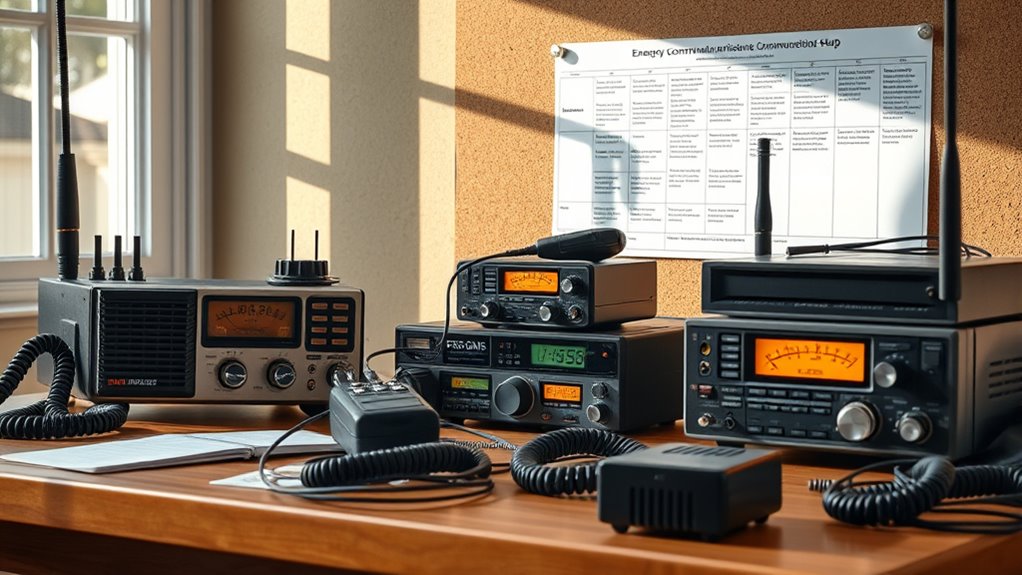
Regular maintenance of your emergency communication equipment is essential to guarantee it works reliably when you need it most. Start by inspecting your radios and accessories regularly for physical damage, such as cracked casings, loose connectors, or worn antennas. Clean contacts, battery terminals, and ports with electronics-safe cleaners to ensure solid electrical connections and clear audio. Check for corrosion or dirt, especially if stored in humid or dusty environments. Properly maintain batteries by recharging fully without overcharging, and only use manufacturer-recommended chargers within the correct temperature range. Remove batteries from devices during long storage to prevent leakage. Keep spare parts like extra batteries, antennas, and cables handy, and update firmware and programming periodically to improve performance and interoperability.
Ensuring Legal Compliance and Proper Radio Operation

Ensuring your emergency radios are operated legally and correctly is crucial for reliable communication and to avoid penalties. Proper compliance keeps your operations smooth and prevents fines or equipment seizures.
Operating emergency radios legally ensures reliable communication and prevents costly penalties.
- Always obtain a GMRS license if you’re using GMRS radios; it’s valid for 10 years and costs $35.
- Transmit your FCC call sign at the end and periodically during transmissions on GMRS frequencies.
- Use only FCC-certified radios and avoid modifying equipment to change frequency or power settings externally.
- Remember, FRS radios are license-free but limited to 2 watts, while GMRS radios can use higher power with external antennas, as long as they meet certification rules.
Following these guidelines helps you stay within legal boundaries and ensures effective, interference-free emergency communication.
Conducting Training and Regular Drills to Enhance Readiness

Conducting training and drills is essential to prepare for real emergency situations. Regular practice helps you become familiar with your radio equipment, whether FRS, GMRS, or ham radios, ensuring you can operate confidently when it matters most. Simulating realistic scenarios allows you to practice communication protocols under stress, reducing errors during actual emergencies. These drills also help identify equipment issues and knowledge gaps before a real incident occurs. Consistent exercises promote teamwork, clarify roles, and improve coordination among volunteers and responders. To be effective, design training that combines theory with hands-on activities, including simulated calls and scenario-based exercises. Schedule sessions periodically—quarterly or semi-annually—to keep skills sharp and procedures updated. Regular drills make your emergency communication system more reliable and ready when needed.
Frequently Asked Questions
How Do I Choose the Best Antenna for Emergency Radio Use?
You should choose an antenna based on your needs for portability, range, and durability. If you need quick deployment, go with stubby or whip antennas for convenience. For long-distance communication, a Yagi or fiberglass antenna offers higher gain and better reach. Consider environmental factors like weather resistance and space, and make certain your antenna is compatible with your radio’s frequency. Proper tuning and grounding will optimize performance.
Can I Upgrade My FRS Radio to GMRS Later?
Upgrading your FRS radio to GMRS is like trying to turn a bicycle into a motorcycle—it’s just not built for that leap. You can’t upgrade FRS radios to GMRS later because they lack the hardware, FCC certification, and power capacity needed for GMRS features. To get GMRS capabilities, you’ll need to buy a certified GMRS radio and get the proper license, as modifications simply aren’t possible or legal.
What Are Common Troubleshooting Steps for Poor Radio Signals?
When you experience poor radio signals, start by checking that your radio is on the same channel and frequency as others. Make sure your batteries are fully charged, and the antenna is vertical and undamaged. Keep the radios at least 40-50 feet apart and away from electronic noise sources. Disable privacy tones and update firmware if needed. Properly tuning squelch and avoiding obstructions will also improve your signal quality.
How Can I Ensure My Radio Batteries Last During Extended Emergencies?
During extended emergencies, you can guarantee your radio batteries last by using low-power transmission settings and turning off your radio when not in use. For example, in a recent scenario, a hiker relied on a rugged, high-capacity radio with power-saving features, conserving battery life during a 72-hour rescue. Regularly rotate batteries, store them properly, and carry portable chargers or solar panels to recharge on the go, extending your radio’s operational time.
Are There Specific Accessories Recommended for Hands-Free Emergency Communication?
For hands-free emergency communication, you should get VOX-enabled headsets with boom mics for clear voice pickup, and earpiece headsets for discreet listening in noisy environments. Use remote speaker microphones clipped to your clothing to keep your hands free, and consider Bluetooth adapters for wireless operation. Enhance your range with tuned, longer antennas, and secure your setup with mounting brackets. These accessories help guarantee reliable, hands-free communication during emergencies.
Conclusion
By following these steps, you’ll be prepared to communicate effectively during emergencies. For example, imagine a community that regularly practices emergency drills using GMRS radios—when a storm hits, they’re able to coordinate rescue efforts seamlessly. Staying informed, maintaining your equipment, and practicing your plan guarantees you’re ready when it matters most. With the right setup and training, you’ll be confident in maintaining clear, reliable communication when emergencies strike.

